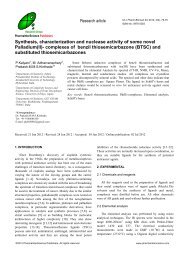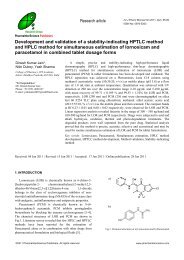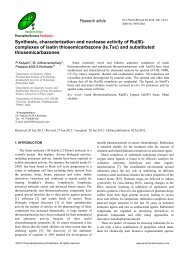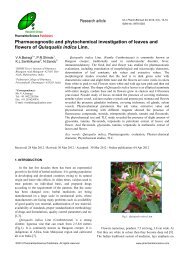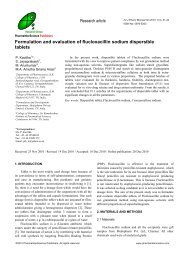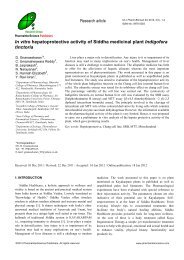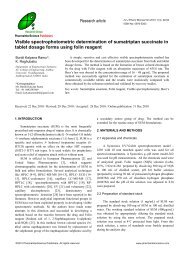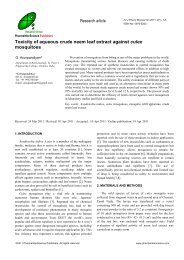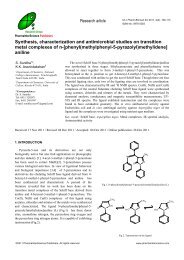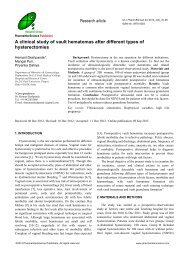Comparision of biofilm production and multiple drug resistance in ...
Comparision of biofilm production and multiple drug resistance in ...
Comparision of biofilm production and multiple drug resistance in ...
Create successful ePaper yourself
Turn your PDF publications into a flip-book with our unique Google optimized e-Paper software.
Research article<br />
Int J Pharm Biomed Sci 2011, 2(4), 103-107<br />
ISSN No: 0976-5263<br />
Research Drops<br />
PharmaInterScience Publishers<br />
<strong>Comparision</strong> <strong>of</strong> bi<strong>of</strong>ilm <strong>production</strong> <strong>and</strong> <strong>multiple</strong> <strong>drug</strong> <strong>resistance</strong> <strong>in</strong><br />
cl<strong>in</strong>ical isolates <strong>of</strong> Ac<strong>in</strong>etobacter baumanii from a tertiary care<br />
hospital <strong>in</strong> South India<br />
M. Dheepa*,<br />
V<strong>in</strong>itha L Rashme,<br />
B. Appalaraju<br />
Department <strong>of</strong> Microbiology, PSG Institute<br />
<strong>of</strong> Medical Sciences & Research Centre,<br />
Peelamedu, Coimbatore- 641004, Tamil<br />
Nadu, India<br />
*Correspondence:<br />
Dr. M. Dheepa<br />
Tel: +91 9843009211<br />
E-mail: dheepamicro@gmail.com<br />
The present work is aimed at to determ<strong>in</strong>e bi<strong>of</strong>ilm formation <strong>in</strong> cl<strong>in</strong>ical isolates<br />
<strong>of</strong> Ac<strong>in</strong>etobacter baumannii <strong>and</strong> to determ<strong>in</strong>e the antibiotic susceptibility pattern <strong>of</strong><br />
seventeen different antibiotics <strong>and</strong> to correlate between bi<strong>of</strong>ilm <strong>production</strong> <strong>and</strong><br />
multi<strong>drug</strong> <strong>resistance</strong>. A total <strong>of</strong> 50 isolates were screened for bi<strong>of</strong>ilm <strong>production</strong> by<br />
both qualitative <strong>and</strong> quantitative method <strong>in</strong> Ac<strong>in</strong>etobacter baumannii isolates.<br />
Bi<strong>of</strong>ilm <strong>production</strong> is demonstrated with st<strong>and</strong>ard tube test method, <strong>in</strong> which<br />
bacterial film l<strong>in</strong><strong>in</strong>g a culture tube is sta<strong>in</strong>ed with a cationic dye <strong>and</strong> visually scaled.<br />
In the second microtitre plate method, the optical density <strong>of</strong> the sta<strong>in</strong>ed bacterial<br />
film is determ<strong>in</strong>ed spectrophotometrically. In bi<strong>of</strong>ilm <strong>production</strong>, both qualitative<br />
(tube method) <strong>and</strong> quantitative (microtitre plate) method showed 30 isolates (60%)<br />
as bi<strong>of</strong>ilm producers. Resistance to antibiotics such as ceftazidime, cefepime <strong>and</strong><br />
pipercill<strong>in</strong> was comparatively higher among bi<strong>of</strong>ilm producers than non-bi<strong>of</strong>ilm<br />
producers .Our <strong>in</strong>vestigations showed a simultaneous emergence <strong>of</strong> <strong>resistance</strong> to<br />
many antimicrobial agents available <strong>and</strong> represent a severe threat <strong>in</strong> the treatment<br />
<strong>of</strong> hospitalized patients. This study demonstrates a high propensity among the<br />
cl<strong>in</strong>ical isolates <strong>of</strong> A. baumannii to form bi<strong>of</strong>ilm <strong>and</strong> a significant association <strong>of</strong><br />
bi<strong>of</strong>ilm with <strong>multiple</strong> <strong>drug</strong> <strong>resistance</strong>.<br />
Key words: Ac<strong>in</strong>etobacter baumanii, bi<strong>of</strong>ilm detection, multi<strong>drug</strong> <strong>resistance</strong><br />
Received: 05 Dec 2011 / Revised: 08 Dec 2011 / Accepted: 11 Dec 2011 / Onl<strong>in</strong>e publication: 28 Dec 2011<br />
1. INTRODUCTION<br />
Ac<strong>in</strong>etobacter baumannii has emerged as an important<br />
<strong>and</strong> problematic human pathogen as it is the causative agent<br />
<strong>of</strong> several types <strong>of</strong> <strong>in</strong>fections <strong>in</strong>clud<strong>in</strong>g pneumonia,<br />
men<strong>in</strong>gitis, septicemia, <strong>and</strong> ur<strong>in</strong>ary tract <strong>in</strong>fections. It is<br />
ranked second after Pseudomonas aerug<strong>in</strong>osa among the<br />
nosocomial, aerobic, non-fermentative, gram negative bacilli<br />
pathogens. Furthermore, this organism frequently causes<br />
<strong>in</strong>fections associated with medical devices, e.g., vascular<br />
catheters, cerebrosp<strong>in</strong>al fluid shunts, foley catheters etc.<br />
Multi<strong>drug</strong>-resistant Ac<strong>in</strong>etobacter baumannii has been<br />
reported worldwide <strong>and</strong> is now recognized as one <strong>of</strong> the most<br />
difficult healthcare-associated <strong>in</strong>fections to control <strong>and</strong> to<br />
treat [1].<br />
Multi <strong>drug</strong> resistant is witnessed only <strong>in</strong> Ac<strong>in</strong>etobacter<br />
baumannii (A. baumannii) <strong>and</strong> not <strong>in</strong> any other species <strong>of</strong><br />
Ac<strong>in</strong>etobacter. Multi<strong>drug</strong>-resistant (MDR) Ac<strong>in</strong>etobacter<br />
baumannii is not a new or emerg<strong>in</strong>g phenomenon, but<br />
Ac<strong>in</strong>etobacter baumannii has always been an organism<br />
<strong>in</strong>herently resistant to <strong>multiple</strong> antibiotics [2]. The potential<br />
ability <strong>of</strong> Ac<strong>in</strong>etobacter baumannii to form bi<strong>of</strong>ilms might<br />
also expla<strong>in</strong> its outst<strong>and</strong><strong>in</strong>g antibiotic <strong>resistance</strong>, survival<br />
properties <strong>and</strong> <strong>in</strong>creased virulence.<br />
Study <strong>of</strong> microbial bi<strong>of</strong>lms has received significance<br />
attention over the past decades. Therefore, studies <strong>and</strong><br />
diagnostic methods identify<strong>in</strong>g virulent bacterial stra<strong>in</strong>s, i.e.,<br />
stra<strong>in</strong>s with a capacity for slime <strong>production</strong> <strong>and</strong> consequent<br />
bi<strong>of</strong>ilm formation are necessary to develop effective<br />
strategies for bi<strong>of</strong>ilm control <strong>and</strong> improvement <strong>of</strong> patient care<br />
[3]. We chose to <strong>in</strong>vestigate bi<strong>of</strong>ilm formation by cl<strong>in</strong>ical<br />
isolates <strong>of</strong> A. baumannii <strong>and</strong> <strong>multiple</strong> <strong>drug</strong> <strong>resistance</strong> among<br />
them <strong>and</strong> tried to correlate them <strong>in</strong> order to underst<strong>and</strong> how<br />
this pathogen persists <strong>in</strong> the hospital environment <strong>and</strong> causes<br />
outbreaks.<br />
2. MATERIALS AND METHODS<br />
A total <strong>of</strong> 50 Ac<strong>in</strong>etobacter baumannii isolates from<br />
samples <strong>of</strong> sputum, ur<strong>in</strong>e, wound swab, tracheal tip, tracheal<br />
aspirate, central l<strong>in</strong>e tip, ear swabs, blood, pus, bronchial<br />
lavage <strong>and</strong> endotracheal tube which were received for a<br />
period <strong>of</strong> six months <strong>in</strong> the microbiology laboratory <strong>of</strong> PSG<br />
©2011 PharmaInterScience Publishers. All rights reserved. www.pharma<strong>in</strong>terscience.com
M. Dheepa et al., Int J Pharm Biomed Sci 2011, 2(4), 103-107<br />
104<br />
hospitals, Coimbatore, South India, were <strong>in</strong>cluded <strong>in</strong> the<br />
study.<br />
2.1 Isolation <strong>and</strong> identification<br />
Blood agar <strong>and</strong> MacConkey agar were used for isolation<br />
<strong>of</strong> Ac<strong>in</strong>etobacter baumannii from the samples. For<br />
identification, a battery <strong>of</strong> biochemical tests were done which<br />
<strong>in</strong>cluded catalase test, oxidase test, carbohydrate fermentation<br />
tests (glucose, lactose, sucrose, <strong>and</strong> mannitol), citrate &<br />
urease tests, OFdextrose test <strong>and</strong> growth at 44°C.<br />
2.2 Antimicrobial suceptibility test<strong>in</strong>g<br />
1<br />
2 3<br />
Antimicrobial susceptibility test<strong>in</strong>g was performed us<strong>in</strong>g<br />
14 different therapeutically relevant antibiotics by Kirby<br />
Bauer disk diffusion method accord<strong>in</strong>g to norms <strong>of</strong> Cl<strong>in</strong>ical<br />
Laboratory St<strong>and</strong>ards <strong>in</strong>stitute (CLSI) <strong>and</strong> the disks were<br />
supplied by Bio-Rad Laboratories, Mumbai.<br />
Fig.1. Bi<strong>of</strong>ilm formation on glass surfaces under static growth conditions.<br />
Tube 1- non adherent, tube 2- weakly adherent, tube 3- strongly adherent.<br />
2.3 Detection <strong>of</strong> bi<strong>of</strong>ilm<br />
2.3.1 Tube method<br />
The quantitative assay for bi<strong>of</strong>ilm formation was<br />
performed accord<strong>in</strong>g to the method described by Christensen<br />
et al 4. Glass tubes filled with 3 mL <strong>of</strong> trypticase soy broth (Hi<br />
media, Mumbai) were <strong>in</strong>oculated with a loopful <strong>of</strong> a pure<br />
culture <strong>of</strong> a stra<strong>in</strong> <strong>of</strong> Ac<strong>in</strong>etobacter baumannii grown<br />
overnight from blood agar plate. After 48 h <strong>in</strong>cubation at<br />
37°C, the content <strong>of</strong> each tube was decanted. The tubes were<br />
then sta<strong>in</strong>ed with 1% safran<strong>in</strong> for 7 m<strong>in</strong>. Then the tubes are<br />
washed with distilled water for 5 m<strong>in</strong>. A positive result was<br />
<strong>in</strong>dicated by the presence <strong>of</strong> an adherent film <strong>of</strong> sta<strong>in</strong>ed<br />
material on the <strong>in</strong>ner surface <strong>of</strong> the tube. Presence <strong>of</strong> sta<strong>in</strong>ed<br />
material at the liquid-air <strong>in</strong>terface alone was not regarded as<br />
<strong>in</strong>dicative <strong>of</strong> slime <strong>production</strong>. Tubes conta<strong>in</strong><strong>in</strong>g trypticase<br />
soy broth only were <strong>in</strong>cluded <strong>in</strong> the test as negative controls.<br />
2.3.2 Microtitre-plate method<br />
Three wells <strong>of</strong> a sterile 96-well flat bottomed plastic<br />
tissue culture plate (Tarson, Kolkata) were filled with 200 µL<br />
<strong>of</strong> bacterial suspension <strong>in</strong> trypticase soy broth <strong>in</strong>oculated at<br />
37°C for 24 h. Negative control wells conta<strong>in</strong>ed broth only.<br />
The plates were covered <strong>and</strong> <strong>in</strong>cubated aerobically for 24<br />
hours at 37°C.Then, the content <strong>of</strong> each well was washed<br />
three times with 250 µl <strong>of</strong> sterile physiological sal<strong>in</strong>e. The<br />
plates were vigorously shaken <strong>in</strong> order to remove all nonadherent<br />
bacteria. The rema<strong>in</strong><strong>in</strong>g attached bacteria were fixed<br />
with 200 µL <strong>of</strong> 99% methanol per well, <strong>and</strong> after 15 m<strong>in</strong><br />
plates were emptied <strong>and</strong> left to dry. Then, plates were sta<strong>in</strong>ed<br />
for 5 m<strong>in</strong> with 0.2 mL <strong>of</strong> 2% crystal violet per well. Excess<br />
sta<strong>in</strong> was r<strong>in</strong>sed <strong>of</strong>f by plac<strong>in</strong>g the plate under runn<strong>in</strong>g tap<br />
water. After the plates were air dried, the dye bound to the<br />
adherent cells was resolublized with 160 µL <strong>of</strong> 33% (v/v)<br />
glacial acetic acid per well. The OD <strong>of</strong> each well was<br />
measured at 578 nm us<strong>in</strong>g ELISA reader (Tulip diagnostics,<br />
India).The read<strong>in</strong>g was performed two times: (i) before<br />
addition <strong>of</strong> glacial acetic acid, as <strong>in</strong> st<strong>and</strong>ard microtitre-plate<br />
test <strong>and</strong> (ii) after glacial acetic acid was added as <strong>in</strong> modified<br />
microtitre-plate test.<br />
For the purpose <strong>of</strong> comparative analysis <strong>of</strong> test results, the<br />
adherence capabilities <strong>of</strong> the test stra<strong>in</strong>s were classified <strong>in</strong>to<br />
the follow<strong>in</strong>g under four categories: non-adherent (0), weakly<br />
(+), moderately (++), or strongly (+++) adherent, based upon<br />
the ODs <strong>of</strong> bacterial films. The cut-<strong>of</strong>f optical density (ODc)<br />
for the microtitre-plate is def<strong>in</strong>ed as three st<strong>and</strong>ard deviations<br />
above the mean OD <strong>of</strong> the negative control.<br />
Stra<strong>in</strong>s were classified as follows:<br />
OD ≤ ODc<br />
non-adherent<br />
ODc < OD ≤ 2 x ODc weakly adherent<br />
2 x ODc < OD ≤ 4 x ODc moderately adherent<br />
4 x ODc < OD strongly adherent<br />
All the tests were carried three times <strong>and</strong> the results were<br />
averaged [5].<br />
3. RESULTS<br />
Twelve Ac<strong>in</strong>etobacter baumannii stra<strong>in</strong>s (24 %) were<br />
isolated from tracheal aspirates. The source <strong>of</strong> each isolate is<br />
shown <strong>in</strong> Table 1. Qualitative tube method <strong>of</strong> bi<strong>of</strong>ilm<br />
screen<strong>in</strong>g showed 30 isolates positive for bi<strong>of</strong>ilm <strong>production</strong>.<br />
In the quantitative assay for the bi<strong>of</strong>ilm <strong>production</strong>, they were<br />
classified as strongly adherent, moderately adherent, weakly<br />
adherent <strong>and</strong> non adherent. Some <strong>of</strong> the isolates show<strong>in</strong>g<br />
bi<strong>of</strong>ilm formation are shown <strong>in</strong> the Fig.1.<br />
For the purpose <strong>of</strong> data calculation, we used classification<br />
<strong>of</strong> bacterial adherence (Table 2 <strong>and</strong> Table 3) based on three<br />
st<strong>and</strong>ard deviations above the mean OD <strong>of</strong> the negative<br />
control [5].<br />
©2011 PharmaInterScience Publishers. All rights reserved. www.pharma<strong>in</strong>terscience.com
M. Dheepa et al., Int J Pharm Biomed Sci 2011, 2(4), 103-107<br />
Table 1<br />
Source <strong>of</strong> ac<strong>in</strong>etobacter baumannii isolates<br />
Culture No (%)<br />
Tracheal aspirate 12 (24)<br />
Sputum 8 (16)<br />
Endotracheal tube 6 (12)<br />
Wound swab 6 (12)<br />
Tracheal tip 5 (10)<br />
Ear swab 3 (6)<br />
Blood 3 (6)<br />
Pus 3 (6)<br />
Ur<strong>in</strong>e 1 (2)<br />
Central l<strong>in</strong>e tip 1 (2)<br />
Foley’ s catheter tip 1 (2)<br />
Bronchial lavage 1 (2)<br />
Total 50 (100)<br />
105<br />
The overall percentage <strong>of</strong> <strong>resistance</strong> observed among<br />
bi<strong>of</strong>ilm positive <strong>and</strong> bi<strong>of</strong>ilm negative isolates <strong>and</strong> <strong>resistance</strong><br />
<strong>of</strong> all the isolates for 17 antibiotics tested, is given <strong>in</strong> Table 6.<br />
This table shows that the <strong>resistance</strong> <strong>of</strong> antibiotics is more for<br />
most <strong>of</strong> the bi<strong>of</strong>ilm positive isolates compared to the bi<strong>of</strong>ilm<br />
negative isolates. Isolates showed maximum <strong>resistance</strong> to<br />
aztreonam 82%, amikac<strong>in</strong> 78% <strong>and</strong> <strong>of</strong>loxoc<strong>in</strong> 76%.<br />
The multi-<strong>drug</strong> <strong>resistance</strong> patterns <strong>of</strong> the bi<strong>of</strong>ilm<br />
produc<strong>in</strong>g Ac<strong>in</strong>etobacter baumannii isolates is shown <strong>in</strong><br />
Table 7. The maximum <strong>multiple</strong> <strong>resistance</strong>s among the<br />
isolates were noticed for anti microbial agents such as<br />
aztreonam, cipr<strong>of</strong>loxac<strong>in</strong> <strong>and</strong> imipenam.<br />
Table 2<br />
Classification <strong>of</strong> bacterial adherence by microtitre plate method<br />
Mean OD value Adherence Bi<strong>of</strong>ilm formation<br />
0.36 Strong High<br />
Table 3<br />
OD values <strong>of</strong> modified microtitre-plate method<br />
Mean OD value Adherence Bi<strong>of</strong>ilm formation<br />
2.28 Strong High<br />
Table 4<br />
Screen<strong>in</strong>g <strong>of</strong> 50 Ac<strong>in</strong>etobacter baumannii isolates for detection <strong>of</strong> bi<strong>of</strong>ilm<br />
<strong>and</strong> the overall results <strong>of</strong> the tube <strong>and</strong> microtitre-plate test<br />
Test<br />
Number <strong>of</strong> stra<strong>in</strong>s show<strong>in</strong>g<br />
No Weak Moderate Strong<br />
adherence adherence adherence adherence<br />
(0) (+) (++) (+++)<br />
Tube method 3 17 17 13<br />
St<strong>and</strong>ard microtitre-plate 1 19 28 2<br />
method<br />
Modified microtitre-plate<br />
method<br />
0 2 29 19<br />
Quantitative microtitre assay for bi<strong>of</strong>ilm formation was<br />
strongly positive <strong>in</strong> 2 isolates <strong>and</strong> moderately positive <strong>in</strong> 28<br />
isolates while the rema<strong>in</strong><strong>in</strong>g n<strong>in</strong>eteen isolates were weakly<br />
adherent <strong>and</strong> one non adherent. N<strong>in</strong>eteen weakly adherent<br />
isolatesalong with onenon adherent stra<strong>in</strong> were considered as<br />
negative or non-bi<strong>of</strong>ilm producers. Both the methods for<br />
bi<strong>of</strong>ilm detection thus showed similar results.<br />
In modified microtitre plate method 19 isolates showed<br />
strong adherence while 29 isolates showed moderate<br />
adherence while others were weakly or non adherent. The<br />
overall results for b<strong>of</strong>ilm detection are given <strong>in</strong> the Table 4.<br />
4. DISCUSSION<br />
Ac<strong>in</strong>etobacter baumannii <strong>in</strong>fections present a global<br />
medical challenge. They are opportunistic pathogens <strong>and</strong> are<br />
particularly successful at coloniz<strong>in</strong>g <strong>and</strong> persist<strong>in</strong>g <strong>in</strong> the<br />
hospital environment. Multi<strong>drug</strong>-resistant Ac<strong>in</strong>etobacter<br />
baumannii has been reported worldwide <strong>and</strong> is now<br />
recognized as one <strong>of</strong> the most difficult healthcare-associated<br />
<strong>in</strong>fections to control <strong>and</strong> treat.<br />
It is also among the most common causes <strong>of</strong> devicerelated<br />
nosocomial <strong>in</strong>fection that results when the organism is<br />
able to resist physical <strong>and</strong> chemical dis<strong>in</strong>fection, <strong>of</strong>ten by<br />
form<strong>in</strong>g a bi<strong>of</strong>ilm. Thus <strong>in</strong>fections due to bacteria that form<br />
bi<strong>of</strong>ilms are a tenacious cl<strong>in</strong>ical problem. Only, few reports<br />
have described the ability <strong>of</strong> cl<strong>in</strong>ical isolates <strong>of</strong> A. baumannii<br />
to attach <strong>and</strong> form bi<strong>of</strong>ilms on glass surfaces. In our study,<br />
the high isolation rates <strong>of</strong> Ac<strong>in</strong>etobacter baumanii <strong>of</strong> about<br />
24 % were from tracheal isolates <strong>and</strong> 16 % from sputum<br />
samples. Another study done <strong>in</strong> Taiwan showed a high<br />
isolation rate <strong>of</strong> Ac<strong>in</strong>etobacter baumanii recovered from<br />
sputum 71% <strong>and</strong> 10% from wound pus [6]. In the present<br />
study done for bi<strong>of</strong>ilm <strong>production</strong>, both qualitative (tube<br />
method) <strong>and</strong> quantitative (microtitre plate) method showed<br />
30 isolates (60%) as bi<strong>of</strong>ilm producers. One <strong>of</strong> the recent<br />
studies had 62% bi<strong>of</strong>ilm positive isolates among the 51<br />
isolates studied, which was comparable with our results [7].<br />
Imipenem <strong>resistance</strong> was 54 % <strong>in</strong> our study. Another<br />
study done <strong>in</strong> Pondicherry India showed 100 % <strong>resistance</strong> to<br />
imipenem [7]. A similar study done <strong>in</strong> Korea revealed 17%<br />
<strong>of</strong> imipenem-resistant isolates [8]. Another study showed<br />
53% <strong>of</strong> A. baumannii which were resistant to carbapenems<br />
from a report <strong>of</strong> a citywide clonal outbreak <strong>in</strong> New York City<br />
[9].<br />
In the 50 isolates used <strong>in</strong> our study, highest sensitivity<br />
was seen <strong>in</strong> netilmyc<strong>in</strong> 72%, then <strong>in</strong> lev<strong>of</strong>lox 62%,<br />
doxycyl<strong>in</strong>e 52%, tobramyc<strong>in</strong> 50%, piperacill<strong>in</strong> + tazobactum<br />
50%, imipenam 46%, ampicill<strong>in</strong>+sulbactum 44%,<br />
cipr<strong>of</strong>loxac<strong>in</strong> 38%, co-trimoxazole 32%, meropenem 32%,<br />
ceftazidime 28%, pipercill<strong>in</strong> 28%, gentamic<strong>in</strong> 28%,cefepime<br />
28%, <strong>of</strong>loxoc<strong>in</strong> 24%, amikac<strong>in</strong> 22% <strong>and</strong> aztreonam 18%<br />
respectively.A study done <strong>in</strong> Bulgaria <strong>in</strong> 2001 showed<br />
highest <strong>resistance</strong> to cipr<strong>of</strong>loxac<strong>in</strong> 97.1%, aztreonam 97%,<br />
amikac<strong>in</strong> 97%, cefepime 96.7%, tetracycl<strong>in</strong>e 95%,<br />
©2011 PharmaInterScience Publishers. All rights reserved. www.pharma<strong>in</strong>terscience.com
M. Dheepa et al., Int J Pharm Biomed Sci 2011, 2(4), 103-107<br />
Table 5<br />
Antibiotic susceptibility pattern <strong>of</strong> the 50 A.baumannii isolates tested are<br />
given <strong>in</strong> this table<br />
Antibiotic<br />
Number (% sensitive)<br />
n=50<br />
Amikac<strong>in</strong> 30 µg 22<br />
Ceftazidime 30 µg 28<br />
Cipr<strong>of</strong>loxac<strong>in</strong> 5 µg 38<br />
Cefepime 30 µg 28<br />
Imipenem 10 µg 46<br />
Pipercill<strong>in</strong> 100 µg 28<br />
Ampicilll<strong>in</strong> + sulbactum 10 µg +10µg 44<br />
Gentamic<strong>in</strong> 10 µg 28<br />
Co-trimoxazole 1.25µg +23.75 µg 32<br />
Doxycyl<strong>in</strong>e 30 µg 52<br />
Piperacill<strong>in</strong> + tazobactum 100 µg + 10 µg 50<br />
Meropenem 10 µg 32<br />
Tobramyc<strong>in</strong> 10 µg 50<br />
Lev<strong>of</strong>loxac<strong>in</strong> 10 µg 62<br />
Aztreonam 30 µg 18<br />
Netilmyc<strong>in</strong> 30 µg 72<br />
Ofloxac<strong>in</strong> 5 µg 24<br />
Table 6<br />
Antibiotic susceptibility results (percentage) <strong>of</strong> A. baumannii isolates<br />
Antibiotics<br />
Resistance <strong>of</strong><br />
Bi<strong>of</strong>ilm positive<br />
isolates N=20<br />
Bi<strong>of</strong>ilm negative<br />
isolates N=30<br />
Amikac<strong>in</strong> 80 73.3 78<br />
Ceftazidime 95 86.6 72<br />
Cipr<strong>of</strong>lox 85 80 62<br />
Cefepime 95 86.6 72<br />
Imipenem 65 70 54<br />
Pipercill<strong>in</strong> 95 93.3 72<br />
Ampicilll<strong>in</strong> + sulbactum 55 66 56<br />
Gentamic<strong>in</strong> 70 70 72<br />
Co-trimoxazole 75 76 68<br />
Doxycyl<strong>in</strong>e 35 56 48<br />
Piperacill<strong>in</strong> + tazobactum 40 50 50<br />
Meropenem 70 66 68<br />
Tobramyc<strong>in</strong> 75 33 50<br />
Lev<strong>of</strong>lox 50 30 38<br />
Aztreonam 85 76.6 82<br />
Netilmyc<strong>in</strong> 20 20 28<br />
Ofloxoc<strong>in</strong> 60 76 76<br />
Table 7<br />
Multiple <strong>drug</strong> resistant patterns <strong>of</strong> A. baumannii<br />
Multiple <strong>drug</strong> comb<strong>in</strong>ations<br />
Number <strong>of</strong> isolates<br />
show<strong>in</strong>g <strong>resistance</strong><br />
Resistance<br />
<strong>of</strong> all<br />
isolates<br />
N =50<br />
Percent<br />
Ak, Ao, Cf, I, Of 31 62<br />
Ak, Ao, I 31 62<br />
Cf, I 33 66<br />
Ak, I, Of 30 60<br />
Ao, Cf, I 33 66<br />
Ak- amikac<strong>in</strong>, Ao- aztreonam, Cf- cipr<strong>of</strong>loxac<strong>in</strong>, I- imepenem, Of –<br />
<strong>of</strong>loxac<strong>in</strong><br />
chloramphenicol 94.7%, amoxicill<strong>in</strong>/clavul<strong>in</strong>ic acid 94.7%,<br />
netilmyc<strong>in</strong> 93.9%, ceftazidime 90.9%, gentamic<strong>in</strong> 87.9%,<br />
pipercill<strong>in</strong>/tazobactam 84.8%, nalidixic acid 84.2%,<br />
tobramyc<strong>in</strong> 75%, imipenem 7.2%, colist<strong>in</strong> 7.1% [10].<br />
106<br />
Another study done <strong>in</strong> Estonia showed 60 % <strong>of</strong> A.<br />
baumanii isolates sensitive to ampicill<strong>in</strong> + sulbactum, 95%<br />
to imepenem <strong>and</strong> meropenum <strong>and</strong> 70 % to amikac<strong>in</strong> [11]. In a<br />
study conducted <strong>in</strong> UK showed <strong>resistance</strong> to piperacill<strong>in</strong> +<br />
tazobactum 39%, imipenam 7%, cipr<strong>of</strong>loxac<strong>in</strong> 46%,<br />
meropenem 0.5%, ceftazidime 46%, pipercill<strong>in</strong> 72%,<br />
gentamic<strong>in</strong> 43%, amikac<strong>in</strong> 21% respectively [12]. Similar<br />
study conducted <strong>in</strong> Ankara <strong>in</strong> 2002 shows the <strong>resistance</strong><br />
rates were 31.2% for netilmic<strong>in</strong>, 44.6% for sulbactamcefoperazone,<br />
53.6% for imipenem, 59.8% for amikac<strong>in</strong>,<br />
59.9% for tobramyc<strong>in</strong>, 74% for cipr<strong>of</strong>loxac<strong>in</strong>, 78% for<br />
gentamic<strong>in</strong>, 79.5% for sulbactam-ampicill<strong>in</strong>, 82.3% for<br />
cotrimoxazole, 84.8% for ticarcill<strong>in</strong>, 87.3% for piperacill<strong>in</strong>tazobactam,<br />
88.1% for ceftazidime <strong>and</strong> 92.1% for piperacill<strong>in</strong><br />
[13].<br />
Another study was conducted <strong>in</strong> USA regard<strong>in</strong>g the multi<br />
<strong>drug</strong> <strong>resistance</strong>. The results showed, about 79.5% (66/83)<br />
were multi-<strong>drug</strong> resistant (MDR) A. baumanii. Among these,<br />
62 were resistant to ceftazidime <strong>and</strong> 66 were resistant to<br />
imipenem. The imipenem resistant isolates (66/83) were also<br />
resistant to kanamyc<strong>in</strong>, amikac<strong>in</strong>, gentamic<strong>in</strong>, streptomyc<strong>in</strong>,<br />
tetracycl<strong>in</strong>e, cipr<strong>of</strong>loxac<strong>in</strong> <strong>and</strong> nalidixic acid [14].<br />
In a study conducted <strong>in</strong> India, Hyderabad Ac<strong>in</strong>etobacter<br />
baumannii showed 77% <strong>resistance</strong> to piperacill<strong>in</strong>-tazobactam<br />
[15]. In another study conducted <strong>in</strong> India, Pune 75% <strong>of</strong> the<br />
isolates were multi<strong>drug</strong> resistant (MDR) <strong>and</strong> <strong>resistance</strong> to<br />
aztreonam 60% <strong>and</strong> for imipenem 29% was noted [16].<br />
In our study bi<strong>of</strong>ilm producers showed <strong>in</strong>creased<br />
<strong>resistance</strong> to Ceftazidime 95%, Cefepime 95% <strong>and</strong> Pipercill<strong>in</strong><br />
95%. A recent study showed significantly higher <strong>resistance</strong> to<br />
cefotaxime, amikac<strong>in</strong>, cipr<strong>of</strong>loxac<strong>in</strong> <strong>and</strong> aztreonam among<br />
bi<strong>of</strong>ilm producers. Non-bi<strong>of</strong>ilm producers showed <strong>in</strong>creased<br />
<strong>resistance</strong> only for netill<strong>in</strong> <strong>and</strong> <strong>of</strong>loxac<strong>in</strong> [7].<br />
5. CONCLUSIONS<br />
In conclusion, cont<strong>in</strong>uous surveillance <strong>of</strong> the <strong>in</strong>-vitro<br />
antimicrobial susceptibility <strong>of</strong> Ac<strong>in</strong>etobacter baumannii<br />
isolates <strong>in</strong> various geographical areas are necessary <strong>in</strong> order<br />
to generate data useful for optimis<strong>in</strong>g empirical antimicrobial<br />
treatment <strong>of</strong> patients with <strong>in</strong>fections that are likely to be<br />
caused by this pathogen. Our <strong>in</strong>vestigation reveals a<br />
simultaneous emergence <strong>of</strong> <strong>resistance</strong> to many antimicrobial<br />
agents when the organisms produce bi<strong>of</strong>ilm <strong>and</strong> represents a<br />
severe threat <strong>in</strong> the treatment <strong>of</strong> hospitalized patients. It is a<br />
challenge to treat <strong>and</strong> also to eradicate this multi<strong>drug</strong><br />
resistant organism because the overall healthcare costs which<br />
are attributed to the treatment <strong>of</strong> bi<strong>of</strong>ilm associated <strong>in</strong>fections<br />
will be much higher. The high rate <strong>of</strong> <strong>in</strong>vitro antibiotic<br />
<strong>resistance</strong> <strong>of</strong> the Ac<strong>in</strong>etobacter baumanii stra<strong>in</strong>s <strong>in</strong>dicate the<br />
importance <strong>of</strong> controlled antibiotic usage <strong>and</strong> appliance <strong>of</strong><br />
hospital <strong>in</strong>fection control measures.<br />
©2011 PharmaInterScience Publishers. All rights reserved. www.pharma<strong>in</strong>terscience.com
M. Dheepa et al., Int J Pharm Biomed Sci 2011, 2(4), 103-107<br />
REFERENCES<br />
[1] Tabassum S. Multi<strong>drug</strong>-resistant ac<strong>in</strong>etobacter: a major nosocomial<br />
pathogen challeng<strong>in</strong>g physicians. Bangladesh J Med Microbiol 2007, 1,<br />
65-68.<br />
[2] Burke A Cunha. Ac<strong>in</strong>etobacter. Emedic<strong>in</strong>e <strong>in</strong>fectious diseases.<br />
[3] Oliveira A, Cunha BA. Bacterial bi<strong>of</strong>ilms with emphasis on coagulase<br />
negative staphylococci. J Venom Anim Tox<strong>in</strong>s <strong>in</strong>cl Trop Dis 2008, 14,<br />
572-596.<br />
[4] Gordan DC, Andrew WS, Janara JY, Larry MB, Fred FB, Dennis MM,<br />
Edw<strong>in</strong> HB. Adherence <strong>of</strong> coagulase – negative staphylococci to plastic<br />
tissue culture plates: a quantitative model for the adherence <strong>of</strong><br />
staphylococci to medical devices. J Cl<strong>in</strong> Microbiol 1985, 1102, 996-<br />
1006.<br />
[5] Srdjan S, Dragana V, Ivana D, Branislava S, Milena SV. A modified<br />
microtitre-plate test for quantification <strong>of</strong> staphylococcal bi<strong>of</strong>ilm<br />
formation. J Microbiol Methods 2000, 40, 175-179.<br />
[6] Po-Ren H, Lee JT, ChengYC, Wen HC, Chong JY, Shen WH, Kwen<br />
TL. P<strong>and</strong>rug-resistant ac<strong>in</strong>etobacter baumannii caus<strong>in</strong>g nosocomial<br />
<strong>in</strong>fections <strong>in</strong> a university hospital. Emerg<strong>in</strong>g Infect Dis 2002, 8, 827-<br />
832.<br />
[7] Sr<strong>in</strong>ivasaRao R, Uma KR , S<strong>in</strong>gh SP, Shashikala P, Kanungo R,<br />
Jayach<strong>and</strong>ran S, Prashanth K. Correlation between bi<strong>of</strong>ilm <strong>production</strong><br />
<strong>and</strong> <strong>multiple</strong> <strong>drug</strong> <strong>resistance</strong> <strong>in</strong> Imipenam resistant cl<strong>in</strong>ical isolates <strong>of</strong><br />
Ac<strong>in</strong>etobacter baumannii. Indian J Microbiol 2008, 26, 333-337.<br />
[8] Seok HJ, Kwon B, Kwang OP, Young JA, Seung GS, Seon JJ, Kwang<br />
HS, Ki SY, Kyungwon L, Dongeun Y, Sang HL. Outbreaks <strong>of</strong><br />
imipenem-resistant ac<strong>in</strong>etobacter baumannii produc<strong>in</strong>g carbapenemases<br />
<strong>in</strong> korea. The J Microbiol 2006, 423-431.<br />
107<br />
[9] L<strong>and</strong>man D, Quale JM, Mayorga D, Adedeji A, Vangala K,<br />
Ravishankar J et al. Citywide clonal outbreak <strong>of</strong> multiresistant<br />
Ac<strong>in</strong>etobacter baumannii <strong>and</strong> Pseudomonas aerug<strong>in</strong>osa <strong>in</strong> Brooklyn,<br />
NY: the preantibiotic era has returned. Arch Intern Med 2002, 162,<br />
1515-1520.<br />
[10] Vatcheva-Dobrevsky R, Savov E, Bernards A, Barselaar M, Dijkshoorn<br />
L. Molecular characterization <strong>and</strong> determ<strong>in</strong>ation <strong>of</strong> antibiotic <strong>resistance</strong><br />
<strong>of</strong> Ac<strong>in</strong>etobacter baumannii isolates from a Bulgarian hospital.<br />
Biotechnol. & Biotechnol. Eq 2005, 19, 166-169.<br />
[11] Krista l, Epp Spp.V Adamson, Piret M, Ulle K,Kar<strong>in</strong> O, Paul<br />
N.Prevailance <strong>and</strong> antibiotic susceptibility <strong>of</strong> Ac<strong>in</strong>etobacter baumannii<br />
<strong>and</strong> Pseudomonas aerug<strong>in</strong>osa <strong>and</strong> Klebsiella pneumoniae <strong>in</strong> Estonian<br />
<strong>in</strong>tensive care units <strong>in</strong> comparison with European data. Sc<strong>and</strong><strong>in</strong>avian J<br />
Infect Dis 2006, 38, 1001-1008.<br />
[12] Carol<strong>in</strong>e JH, Tess G, Mar<strong>in</strong>a W, Dorothy J, Mark WS. Antibiotic<br />
<strong>resistance</strong> among cl<strong>in</strong>ical isolates <strong>of</strong> Ac<strong>in</strong>etobacter baumannii <strong>and</strong> <strong>in</strong><br />
vitro evaluation <strong>of</strong> tigicyl<strong>in</strong>e. Journal <strong>of</strong> Antimicrobial Chemotherapy<br />
2002, 49, 479-487.<br />
[13] Antibiotic <strong>resistance</strong> <strong>of</strong> Ac<strong>in</strong>etobacter baumannii isolates: data from<br />
Ibni S<strong>in</strong>a Hospital for the year 2002. Mikrobiyol Bul 2003, 37, 241-246.<br />
[14] Vijaya BS, Gov<strong>in</strong>dan R, Preeti P, Kurt S, Daniel T, Prapas P, Mario M,<br />
Wondwossen AG. Genetic relatedness <strong>and</strong> molecular characterization <strong>of</strong><br />
multi<strong>drug</strong> resistant Ac<strong>in</strong>etobacter baumannii isolated <strong>in</strong> central Ohio,<br />
USA. Ann Cl<strong>in</strong> Microbiol Antimicrob 2009, 8, 21.<br />
[15] Anuradha K, Sailaja VV, Umabala P, Satheesh T, Lakshmi V.<br />
Sensitivity pattern <strong>of</strong> gram negative bacilli to beta lactam/ beta<br />
lactamase comb<strong>in</strong>ations us<strong>in</strong>g the automated API system. Indian J Med<br />
Microbiol 2007, 25, 203-208.<br />
[16] Joshi SG, Litake GM, Niphadkar KB, Ghole VS. Multi<strong>drug</strong> resistant<br />
Ac<strong>in</strong>etobacter baumannii isolates from a teach<strong>in</strong>g hospital. Journal<br />
Chemother 2003, 9, 187-190.<br />
©2011 PharmaInterScience Publishers. All rights reserved. www.pharma<strong>in</strong>terscience.com




